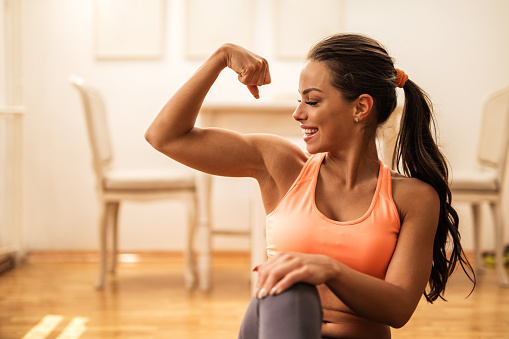 You’re always welcome at the gym, but that’s not the only place you can improve your muscle tone. Your own body weight and common household items provide you with everything you need to keep working towards toned arms at home. Three exercises that will help you get the definition you want are:
You’re always welcome at the gym, but that’s not the only place you can improve your muscle tone. Your own body weight and common household items provide you with everything you need to keep working towards toned arms at home. Three exercises that will help you get the definition you want are:
Push-ups are “classic” arm- and chest-toning exercises that offer a lot of versatility to target various muscle groups in your upper arms and pectoral region.
The basic push-up involves starting in plank position—flat back, arms fully extended (but without locking your elbows) directly below the shoulders—and lowering your upper body slowly toward the floor by bending at the elbows…and then pushing back up to plank position by straightening your elbows. Inhale as you go down, exhale as you push up.
Modifications to work your entire upper arm and chest region include:
Elevated push-ups are a good modification for people with weak shoulders or recovering from a shoulder injury. Elevated push-ups are a basic push-up done on a surface higher than the floor. For instance, you may do a basic push-up with your hands resting on a step of a staircase or against a couch or chair. (If you use furniture for elevated push-ups, make sure it is secured against a wall so that it will not move or slip when bearing your weight.)
Tricep raises target the muscle group on the back of your upper arms—the part that, often when untoned, leads to “bye bye flab.”
To perform a basic tricep raise:
You can also use resistance bands (instead of weights) for standing tricep raises.
Deltoid raises involve lifting from the shoulders, working the uppermost part of your arms and shoulder blades. A basic deltoid lift can be done with or without weights or resistance bands by:
You can vary the angle of arm raise, bringing your arms out to the sides to target, to more fully work the deltoid area.
While you are toning your arms at home, take a few minutes (less than, actually) to tone the muscles in your back, which will improve your posture (and healthy postural alignment is vital to pain-free living). One exercise that will strengthen your upper back and core is the wall sit:
Hold this position for 45 seconds. As you gain strength, you can extend the amount of time you stay in the position up to 90 seconds.
If you would like more recommendations for at-home exercises to keep you working towards your fitness goals between workouts at ICWA, talk to one of our trainers.